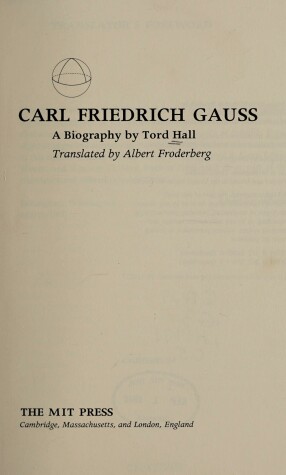Carl Friedrich Gauss (1777-1855) is generally ranked with Archimedes and Newton as one of the three greatest mathematicians that ever lived. His work, in terms of its all-pervasive importance, its painstaking attention to detail, and its completely developed beauty, somehow reminds one of the work of Beethoven, his contemporary and compatriot. Gauss was the last of the truly universal mathematicians and scientists, whose realm embraced virtually all the domains of pure and applied mathematics, and astronomy, and theoretical and experimental mechanics, hydrostatics, electrostatics, magnetism, optics.... "Gaussian" as a modifier has been applied to a remarkable assortment of mathematical terms, and "gauss" is the universal unit for the intensity of magnetic force.Tord Hall's biography concisely presents the outer events of Gauss's life, but the emphasis is, as it should be, on the inner core of that life--the mathematical creations. These are unfolded in such a way as to be clearly understandable to readers of modest mathematical attainment, but more than that, such readers are given a proper sense of the intellectual excitement and aesthetic completeness of Gauss's achievement.Gauss's external life was fairly uneventful and conventional. His solid, conservative, burgherlike exterior served to mask and protect an incredibly fecund mental flux, as evidenced by a fifty-year period of unflagging creative output. During this time he was Director of the Astronomical Observatory in Gottingen and as such rarely gave formal lectures on purely mathematical subjects. In addition, because of his Olympian reserve and standoffishness from his colleagues, he was disinclined to present his discoveries informally; he chose instead to reveal them only when they were embodied in the form of perfectly developed papers, which can be regarded as integral works of art, finished and unutterable.This disposition prevented Gauss from adding still more illustrious discoveries to his credit: for besides those presented in the large body of his formal papers, a study of his journal and other posthumous papers reveals that he had achieved (but did not publish, because he had not developed the work up to his high standards of completeness and rigor) some of the most important results later obtained by Abel, Cauchy, Jacobi, and others. Gauss combined an acute sense of priority of discovery with distaste for public controversy, and made his claims discretely, in personal letters. Hall's account makes full use of these letters and the journal entries.In describing Gauss's work, the author carefully describes the problems Gauss set for himself, and the solutions he uncovered. Hall also outlines the mathematical approach or "style" of the proofs--the lines joining the problems and the solutions--when these are too involved to be presented in full form. The topics so discussed include (among others) the fundamental theorem of algebra, the 17-gon, geodesic triangles and Gaussian curvature, non-Euclidean geometry, elliptic functions, arithmetic residues, and the determination of Ceres' orbit, and the first workable telegraph, constructed in collaboration with Wilhelm Weber.
- ISBN10 0262080400
- ISBN13 9780262080408
- Publish Date 22 July 1970
- Publish Status Out of Print
- Out of Print 17 September 2010
- Publish Country US
- Publisher MIT Press Ltd
- Imprint MIT Press
- Format Hardcover
- Pages 208
- Language English
